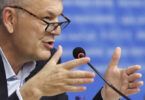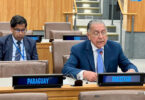F.P. Report
WASHINGTON DC: Chairman Smith chairs the full committee hearing on Thursday. They discuss the Fiscal Year (FY) 2023 Budget for the Department of the Army and was joined by Secretary of the Army, Christine Wormuth, and Chief of Staff of the Army, General James McConville.
As we write this year’s NDAA, we must keep in mind the old and new challenges facing us, including the first real threat of land war in Europe since the end of World War II and the rapid growth of risk in the Pacific. This year’s Army Budget Request attempts to manage risk at an acceptable level, with a mix of investments in modernization, readiness, and end s-trength. We are eager to he-ar from our witnesses what opportunities and challenges are built into their FY 2023 Budget. This Co-mmittee wants to know wh-at help the Army needs to achieve real progress to be-come a force that reliably deters adversaries and is re-ady, if necessary, to win a twenty-first century conflict.
Modernization is a key goal of this year’s request. Themes from previous years continue in this request, and I appreciate the efforts of Secretary Wormuth and her team to refocus and adapt Army modernization toward stable, affordable, and achievable priorities. After more than three years of insights gained from new technology development, rapid prototyping, and experimentation, it does seem that the Army is not as “locked in” to its long standing “31+4” specific programs.
The FY 2023 request supports this evolution in prioritization and investment to fulfill combatant commander requirements, particularly for a future near-peer conflict, highlighted by significant inve-stment in the long-range hypersonic weapon, rocket artillery, next generation medium and armed reconnaissance helicopters, a new short-range air defense (SHORAD) system, and the tactical network. The A-rmy’s network modernization is particularly important and must make the most of new technology that ensures its thousands of units and weapon systems on the battlefield are a functioning part of the joint force that is seamlessly and continuously connected, survivable, and capable of decisive land operations. We must keep a close eye on how these units and systems connect and operate as part of the joint force and how we ensure their survivability.
For many years, Army readiness has been challenged by high operational tempo and global demand for rotational forces, and this year’s end strength request is 12,000 below last year’s authorized level. This is a concerning departure from year over year increases for the Army, and I want to hear from our witnesses how the anticipated reduction in global force demand or tradeoff for modernization supports this strategy.
Furthermore, the Army is continuing to institute a new unit life cycle model named the Regionally Aligned Readiness and Modernization Model (ReARMM), with the goals of relieving operational strain and training on modernized equipment. While this change is still currently underway, we expect the Army will keep the Com-mittee informed on how this new force generation model will impact training and maintenance requirements, budgetary decisions, modernization efforts, and readiness of the force.






